
mech:0.1::193
From such shreds of evidence we piece together the tall tales we call scientific
models." ---Cinna Lomnitz, "Earthquake Prediction"
mech:0.15::255

What do witnesses see when a failure occurs?
Most often it has been the occurrence of sand boils near the toe of the levee, followed by
overtopping. In most recent cases the river did not rise above the top of the levee; rather,
the levee failed, sinking below the river level.
mech:1:boils.gif:98

One traditional model of piping failure is based
on the analysis of Terzaghi and predecessors who studied several catastrophic failures of
concrete dams built on river alluvium. The model seepage was based most usually on the
assumption of a uniform isotropic medium within which a coherent field of seepage pressure
developed following principles of heat or electric flow developed in the nineteenth century.
Interestingly these methods arose at the same time as Lyell was promulgating his doctrine of
uniformitarianism, a Victorian era governed by paternalistic, Protestant ideas about the world
or if the world was not actually that way, how the world should be described. This image of
the world continues to appeal, and among those groups to whom it appealed most powerfully was
engineers, Northern European paternalists with a strong hand for command and control.
mech:3:lf22.gif:154

We have seen how this analytical technique
realized in the form of a flow net from led the Corps of Engineersto reach the comforting
conclusion that the upward gradient was a mere XX, well below what would be required to cause
significant sand boils.
mech:5:lf23.gif:155
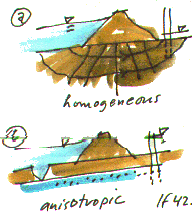
Levee designers are schooled in soil mechanics,
which features theoretical models which assume homogeneous characteristics to the ground.
Analysis based on homogeneity (encouraged by borings that are too shallow) suggests that flood
pressures at the levee toe will be innocuous as in A. What, if as is more often the case,
there is a ravel layer at a depthless than about 50 feet? Pressures can substantially exceed
the "homogeneous" assumption. Suppose, further, that the gravel bed is truncated on the land
side of the levee, and accessible to flood water via a pit on the river side of the levee? A
potential for doubling the pressures exist, resulting in very large uplift and erosive
potential at the toe. Analysis, untempered by experience in field geology, often leads to
unsafe conclusions.
mech:5.5:lf42.gif:149

The permeability of the gravel layer is the main
determinant of how seepage occurs, including the type and size of concentrated seepage from
boils (equivalent to yield of a small well) and the rate of movement of a pressure have
horizontally through the layer. Test results show that the gravel layer consists of about 70
percent gravel to 2 inch size with some coarse sand, soil "C" above, with behavior as
indicated. Soil classification (by standard techniques) serves as a basis for estimating
permeability, K, steady sand boil discharge, and erosive capacity.
Continue...
mech:9:lf32.gif:163

The pressures beneath the toe can be determined
by drawing a flow net. Equipotentials and lines of flow must then approach square
shapes to meet the equations of filed. I drew these beginnings of a flow net at the Denver
airport while waitn 5 hours for a flight to SanFrancisco. They are pretty crude but I think
that you can see that the case on the right, where seepage has insinuated a 12 ft head under
the model in a presumed gravel layer is a lot worse than the case on the left.
mech1:9.5:lf48.gif:183
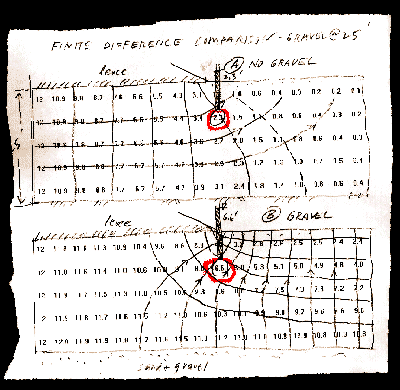
Clearly the precision of a flow net has its
limitations; refininement can be achieved by setting up a small cross section as a finite
difference equation on a spreadsheet. In the example I've shown here it is quite clear that
the "gravel layer" has a greta influnece on the pressures beneath the toe of the levee,
resulting of a factor of safety approaching 1 for development of a quicksand condition at the
tow. Clearly under such conditions a head of 12 or so beneath the central part of the levee
results in failure of the levee foundation and slippage of the toe.
mech1:9.8:flownets.gif:184

The mathematically ideal underseepage flow creates
toe pressures equal to one half the river level.
mech1:10:u2.gif:74

The real underseepage flow may create toe
pressures equal to the river level.
mech1:11:u1.gif:75

The difference in pressure beneath the
downstream section of the leveee is shown in the foundation pressure profile at a depth of 5
ft into the foundation. Obviously the sand layer makes a big difference so it is an important
boundary condition to the problem.
mech1:15:lf49.gif:185

In effect we have a 6 million cubic foot leaky
bladder (200 x 30 x 1000) of very loose sand. In the early stages the pressure will be
confined by the overlying strata (except for D'Arcy flow). At a gradient of 0.5 to 0.7 sand
boils will develop with flow constrained by the ability of the gravel to supply water to a
single well. If this amount does not exceed a few gallons a minute, the ability to create a
large boil in several hours will be limited. If however the gravel delivers flows of several
hundred gallons a minute -- and we know from local irrigation well experience that this is the
case -- then the potential for a large boil, a rough pipe several miles in diameter, exists
with potential for discharge of liquefied sand limited only by the fluid dynamics of liquefied
material. Continue...
mech1:16:lf27.gif:159
Why levees may fail after the flood peak
mech2:0.1::205

Why is there a lag time? Before sand boils
develop it is necessary to "inflate" the sand boil breaks out. For each foot of levee as much
as 100,000 gallons of water must enter the aquifer, a process that takes many hours.
Similarly, as the flood recedes, the inflated aquifer remains pressurized, perhaps dangerously
so, for hours after high water. Continue...
mech2:1:lf30.gif:161

Engineers use mathematical "models" to
evaluate, predict, and manage physical processes.
On January 27, I sketched out a model of the flow process beneath a typical Feather River
levee
that was underlain
by an old river channel. To make it simple, I broke down the physical system into several
cells;
for example, cell (1) is the channel on the river side of the levee. It gets water from the
river and feeds it into the levee foundation, cell (2).

Each cell needs to be told something about itself; how permeable are its walls, how quickly
does water flow through it, how much does it swell when pressurized. These define how fast
a pressure wave will migrate through the foundation from the water to the land side of the
levee.

These factors can be combined into a set of differential equations, or, as I've done here,
into a step-by-step finite difference model.
mech2:2:scalc1.gif:79
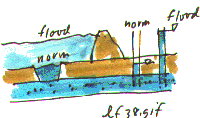
TIME LAG: Artesian pressures of about 15 feet
are sufficient to cause uplift of the toe. These pressures take time to develop; it is
necessary to pump water into the gravel to raise the pressure. Alternatively, each 100 foot
cell requires 10 cubic feet of water to raise the pressure a foot. This results in a wave of
pressure moving from the river to the landside. This process can be modeled on a spreadsheet.
Principal variables are permeability of gravel and access of water to it.
mech2:3:lf38.gif:178

The increase in water pressure causes buoyancy
to develop in the sand, with changes in pressure at 30 feet depth reducing from 30 psi to
perhaps a third of that value. This carries ground heave of several inches (estimate 6
inches). Flood survivors describe a scene of zoological panic: snakes appear and the orchards
fill with panic stricken badgers, skunks, and deer, like the famous fire scene from "Bambi."
mech2:4:lf29.gif:160
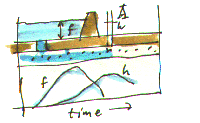
The model indicates that a pressure wave passes
beneath the levee.
mech2:5:lf36.gif:176
Mechanics of a levee failure: what happens at failure?
mech3:0.1::217

Here is one depiction of the failure
mechanism.
mech3:0.5:boilsb.gif:99

What is the process of final failure? No one knows
for sure. But this illustration suggests a general likelihood, without providing all of the
details. Continue...
mech3:1:u3.gif:109
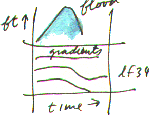
According to the model the history of the upward
seepage gradient is as shown. By the time the actual failure, the gradient is predicted to
be 0.5? Which is sufficient to cause heavy sand boils and also weaken the toe to the point of
sliding of the levee toe.
mech3:2:lf34.gif:174
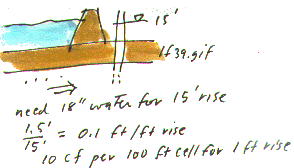
Typically, a rise of artesian toe pressure of 15
feet would assure failure. It would be sufficient to create near uplift of a 30 ft thick
topstratum with unit weight of 100 lbs/cu ft.. Considering the saturation and swelling of the
top stratum in the affected area, inflow of about 18 inches of water, or 0.1 ft water per foot
of head change, would accompany this pressure rise.
mech3:3:lf39.gif:179
Mechanics of a levee failure: How pits make matters worse
mech4:0.1::216

Breaches in the top stratum by pits on the river
side results in faster and larger buildup of pressures beneath the toe.
mech4:1:lf35.gif:175
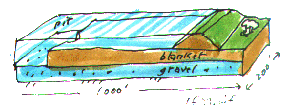
We see here a case in which a pit may exist 1000
feet away from a levee. Using simple D'Arcy flow theory we can examine separately the
relative influence of a pit with seepage through a natural 20 ft. floodplain blanket. Results
indicate that each could contribute about 0.6 cfs or 250 gallons per minute; the pit even
1000 feet away significantly influences boil discharge. ( Separate calculation of these two
cases is not rigorously correct, but it is an informative approximate start on the problem.)
mech4:2:lf33.gif:164

Here is visual comparison between the 1986 and 1997 levee failures and the location of pits dug in the floodplain near the levees. Both photographs are the same scale.
Artificial pits were present at both failure sites as shown in the photographs (same scale).
Pits are 1000 to 2000 ft. away from the failure points, in line with old channels that pass
beneath the levees.
mech4:2:linda.gif:123
Questions or Comments?